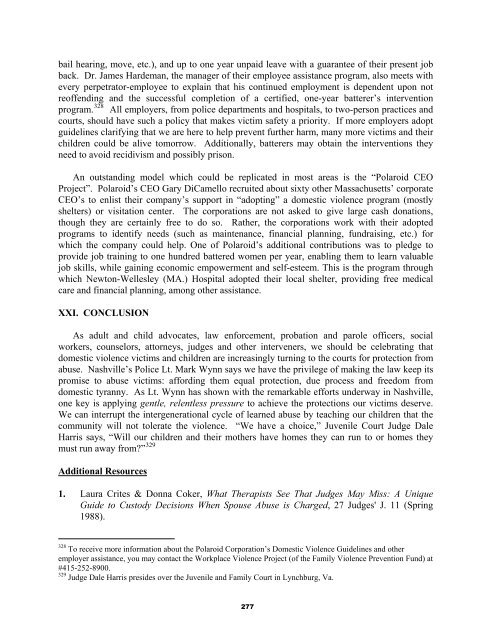A Judge’s Guide
A Judge’s Guide
A Judge’s Guide
Create successful ePaper yourself
Turn your PDF publications into a flip-book with our unique Google optimized e-Paper software.
ail hearing, move, etc.), and up to one year unpaid leave with a guarantee of their present job<br />
back. Dr. James Hardeman, the manager of their employee assistance program, also meets with<br />
every perpetrator-employee to explain that his continued employment is dependent upon not<br />
reoffending and the successful completion of a certified, one-year batterer’s intervention<br />
program. 328 All employers, from police departments and hospitals, to two-person practices and<br />
courts, should have such a policy that makes victim safety a priority. If more employers adopt<br />
guidelines clarifying that we are here to help prevent further harm, many more victims and their<br />
children could be alive tomorrow. Additionally, batterers may obtain the interventions they<br />
need to avoid recidivism and possibly prison.<br />
An outstanding model which could be replicated in most areas is the “Polaroid CEO<br />
Project”. Polaroid’s CEO Gary DiCamello recruited about sixty other Massachusetts’ corporate<br />
CEO’s to enlist their company’s support in “adopting” a domestic violence program (mostly<br />
shelters) or visitation center. The corporations are not asked to give large cash donations,<br />
though they are certainly free to do so. Rather, the corporations work with their adopted<br />
programs to identify needs (such as maintenance, financial planning, fundraising, etc.) for<br />
which the company could help. One of Polaroid’s additional contributions was to pledge to<br />
provide job training to one hundred battered women per year, enabling them to learn valuable<br />
job skills, while gaining economic empowerment and self-esteem. This is the program through<br />
which Newton-Wellesley (MA.) Hospital adopted their local shelter, providing free medical<br />
care and financial planning, among other assistance.<br />
XXI. CONCLUSION<br />
As adult and child advocates, law enforcement, probation and parole officers, social<br />
workers, counselors, attorneys, judges and other interveners, we should be celebrating that<br />
domestic violence victims and children are increasingly turning to the courts for protection from<br />
abuse. Nashville’s Police Lt. Mark Wynn says we have the privilege of making the law keep its<br />
promise to abuse victims: affording them equal protection, due process and freedom from<br />
domestic tyranny. As Lt. Wynn has shown with the remarkable efforts underway in Nashville,<br />
one key is applying gentle, relentless pressure to achieve the protections our victims deserve.<br />
We can interrupt the intergenerational cycle of learned abuse by teaching our children that the<br />
community will not tolerate the violence. “We have a choice,” Juvenile Court Judge Dale<br />
Harris says, “Will our children and their mothers have homes they can run to or homes they<br />
must run away from?” 329<br />
Additional Resources<br />
1. Laura Crites & Donna Coker, What Therapists See That Judges May Miss: A Unique<br />
<strong>Guide</strong> to Custody Decisions When Spouse Abuse is Charged, 27 Judges' J. 11 (Spring<br />
1988).<br />
328 To receive more information about the Polaroid Corporation’s Domestic Violence <strong>Guide</strong>lines and other<br />
employer assistance, you may contact the Workplace Violence Project (of the Family Violence Prevention Fund) at<br />
#415-252-8900.<br />
329 Judge Dale Harris presides over the Juvenile and Family Court in Lynchburg, Va.<br />
277


